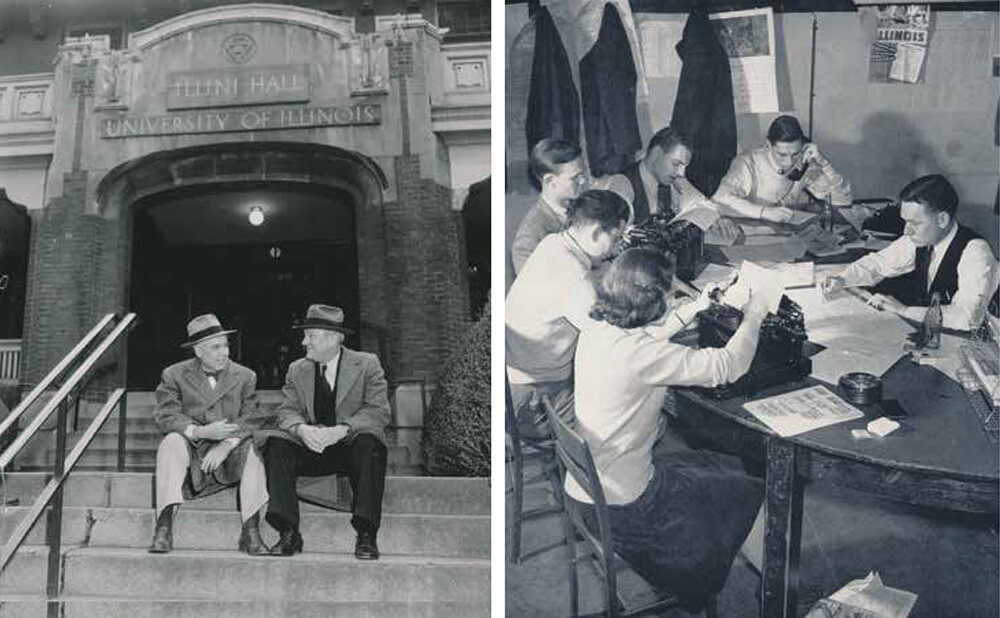Memory Lane: Illini Hall—In Memoriam
 The University YMCA. The U of I’s first student union. The birthplace of Illinois Homecoming. Illini Hall played many roles over the past century. Illini Hall in the 1940s. (Image courtesy of UIAA)
The University YMCA. The U of I’s first student union. The birthplace of Illinois Homecoming. Illini Hall played many roles over the past century. Illini Hall in the 1940s. (Image courtesy of UIAA) The corner of Wright and John streets in Champaign will soon be home to a new data sciences center, built as part of the University’s $192 million Altgeld Hall Project. But for 114 years, through world wars and global pandemics, boom times and busts, that corner has been the domain of Illini Hall, a red-brick wreck of a building that sometimes verged on collapse, yet became a beloved icon for generations of Illinois students.
Today’s alumni remember the building only as Illini Hall—as natural an appellation as you’ll find on campus—but that wasn’t always its name. Like many academic buildings that crack the century mark, it evolved with the times and the needs of the University, changing its identity and purpose more than once.
When the building opened in 1908, it was the University YMCA, a source of Christian fellowship, student housing and support services, and a social space for men on campus.
It was as a social space that the building first joined the annals of University history, when in 1910 it became the birthplace of Illinois’ Homecoming tradition.
According to legend, U of I seniors Walter Elmer Ekblaw, 1910, LAS, and Clarence Foss Williams hatched the idea for Homecoming on the front steps, and the campus’ senior honorary societies planned the first year’s events in the basement. The rest, as they say, is history.
But the YMCA building was just getting started.
Less than a decade later, it took the spotlight once again when the University leased the building, renamed it Illini Hall and refashioned the basement as “The Illinois Union”—providing a quick solution to a growing problem: an angry student body.
Undergraduates had been trying to convince the University to build a student union since 1909, but their campaigns had been stifled by lackluster fundraising and administrative punting. Following World War I, fueled by the spirit of Allied victory, the students finally demanded action.
What they got was Illini Hall.
Yet, as slapdash as it was, the new “Union” served its purpose: it soon became the place to go for billiards, social events and leisure activities of all kinds. Within months, students were calling Illini Hall “The Illinois Union Building”—a name that stuck—and it served as their home away from home throughout the 1920s.
But by the middle of the Great Depression, the “Union” was in danger of collapsing, despite being only 25 years old.
“What this campus really needs,” argued a student journalist in 1934, “is a new Union building.” The U of I finally agreed, and seven years later, the Illini Union we know and love opened to the public.

The founders of Homecoming, where inspiration struck, 1953 and The Daily Illini staff in their headquarters, 1940. (Images courtesy of UI Archives)
By then, the old Y was back to its “new” name, Illini Hall, and a new tenant, The Daily Illini, had moved into the basement. From 1938 to 1988, thousands of Illinois students—including Roger Ebert, ’64 MEDIA, Paul Ingrassia, ’72 MEDIA, and Iris Chang, ’89 MEDIA—learned what it meant to be a journalist in the DI’s subterranean headquarters. “We took a lot of pride in producing a real-world newspaper with all its responsibilities and consequences,” says former DI editor Vanessa Faurie, ’87 MEDIA, MBA ’15. “We took what we did very seriously, but we also had so much fun working, learning and being together.”
In later decades, Illini Hall served as headquarters for the U of I Police Training Institute and the Dept. of Statistics.
But for many alumni, Illini Hall is synonymous with the student newspaper, its longest tenant.
For the DI staffers who worked there, Illini Hall will always be a special place, despite its “gloomy” appearance.
“It was pretty unremarkable on the outside and even less remarkable on the inside,” says former editor Patrice Wingert-Kelly, ’77 MEDIA, “but it was our true home on campus. The idea that it’s being reduced to rubble is more than a little heartbreaking.”
“But buildings are buildings,” says former DI reporter Jim Schlueter, ’80 MEDIA. “It’s the people who make those buildings come alive and remain in our hearts.”


